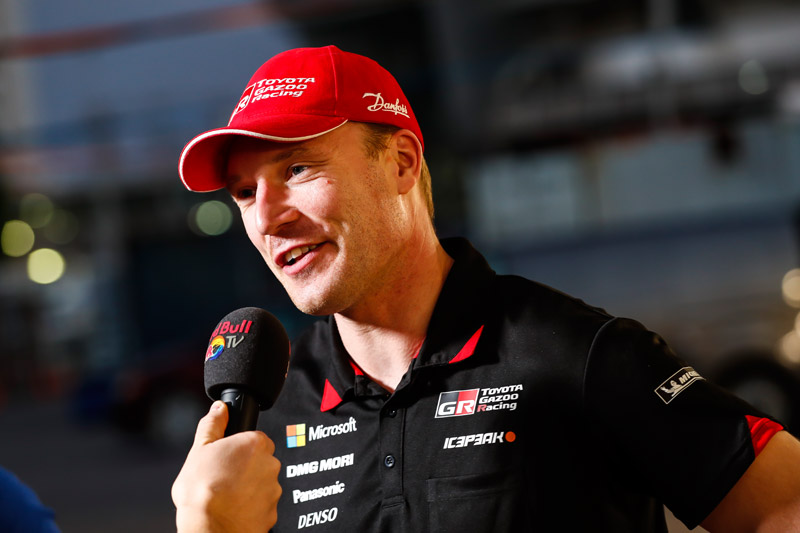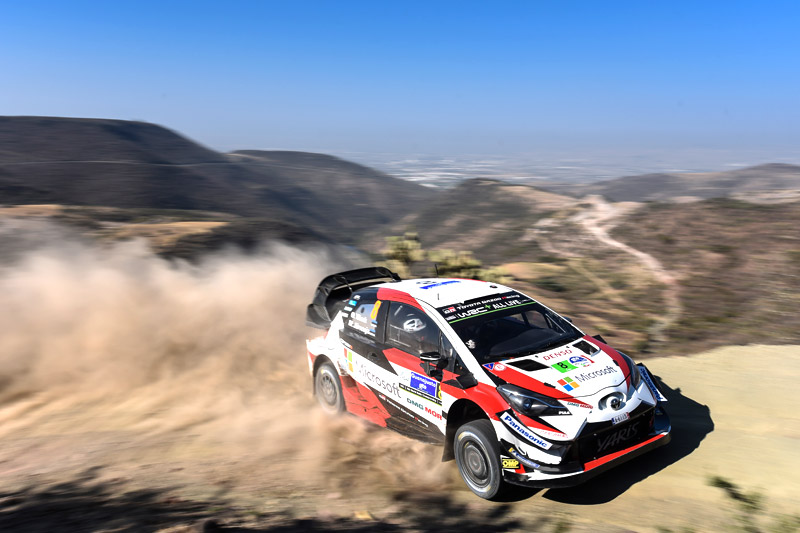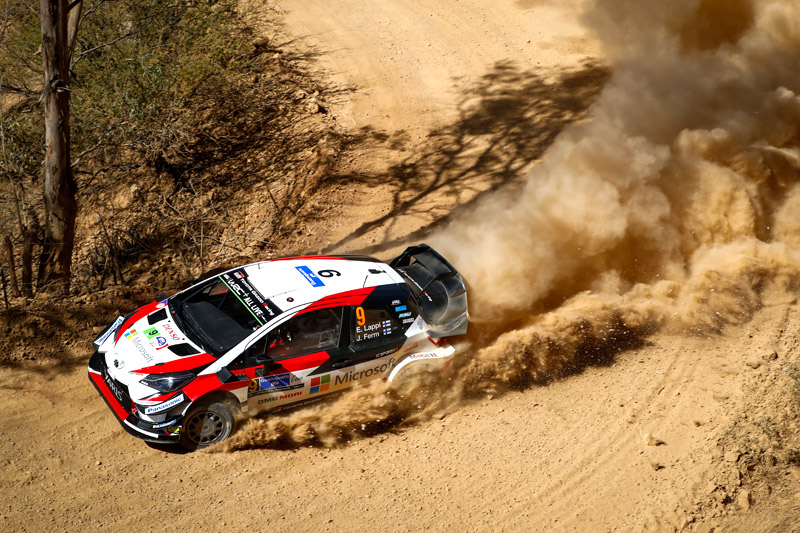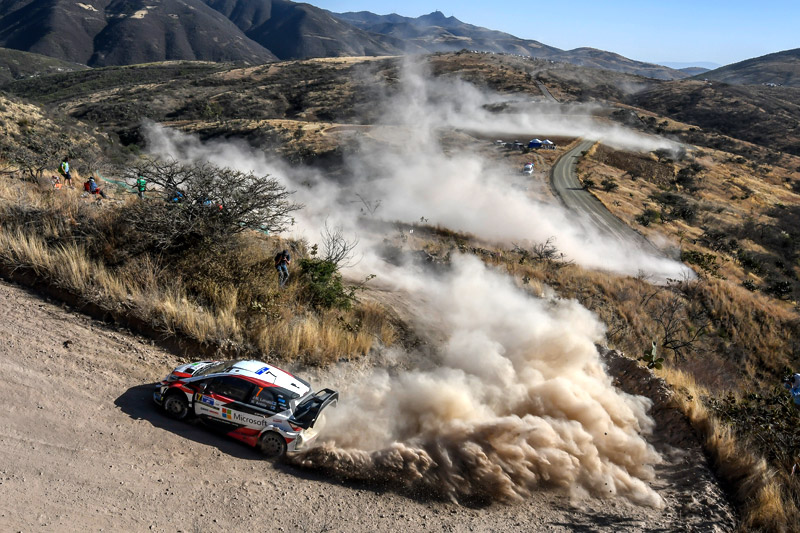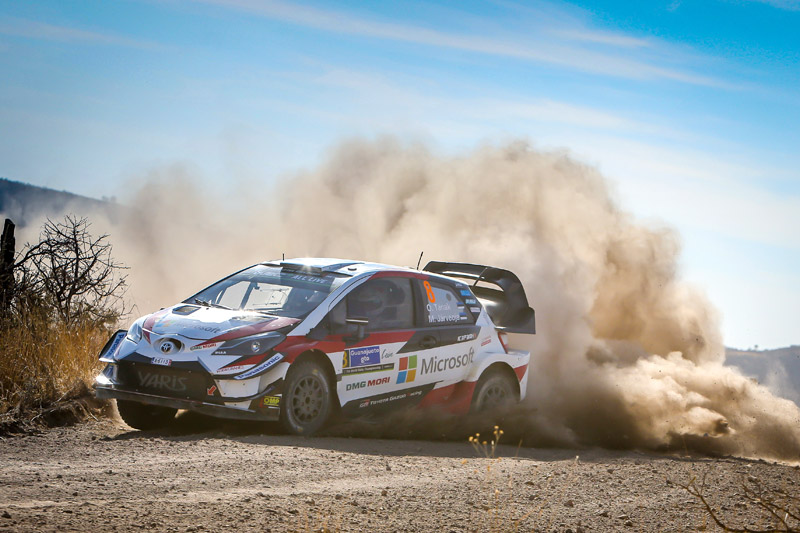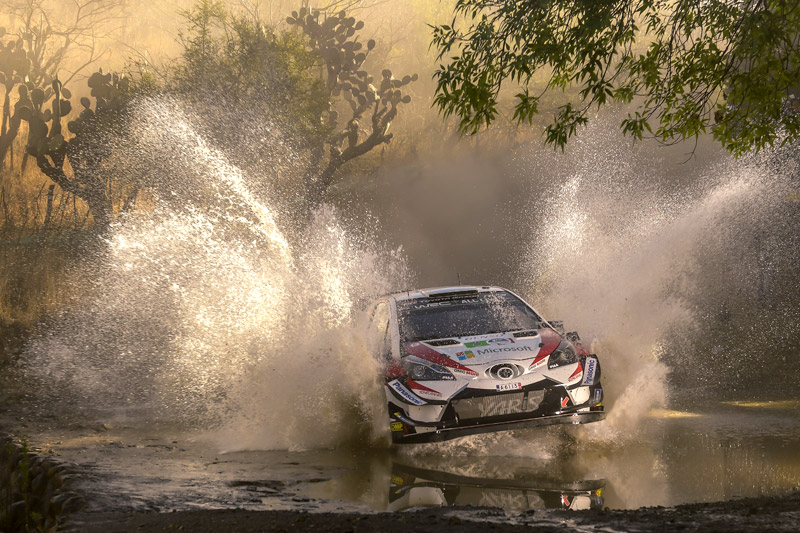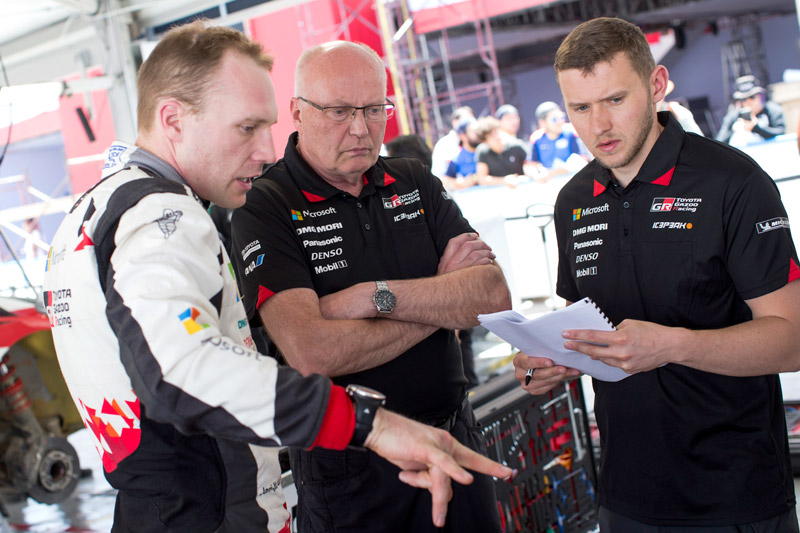RALLY MEXICO
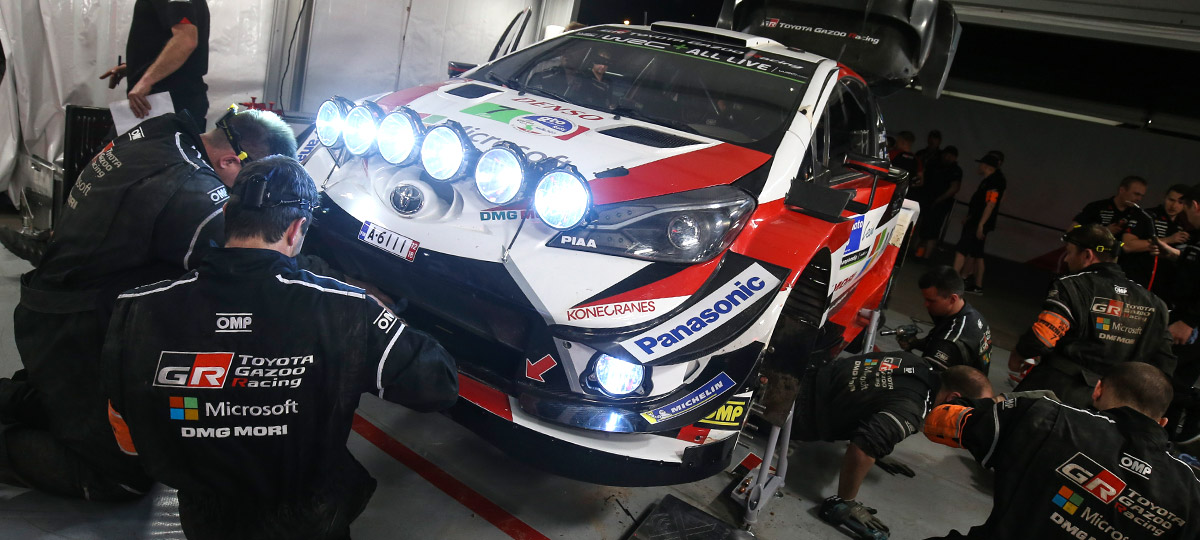
In unexpectedly high temperatures, TOYOTA GAZOO Racing endures a disappointing rally for the second year in succession
However, the data acquired by the team will be utilized to make ever-better cars
The first two rallies of the season, Rallye Monte-Carlo and Rally Sweden, were both winter events played out in snow-white conditions; now, the WRC was heading into the spring rounds. The stage for round three was Mexico, where temperatures are extremely high even in March. For people who ordinarily live and work in Europe and Japan, the conditions even this early in the year resemble summer. In fact, in León in the central Mexican highlands, where the service park was located, morning temperatures exceeded 20˚C, with highs of around 30˚C during the day.
Speaking after his recce (an abbreviation of “reconnaissance,” where drivers check out the courses before the start of the rally), Jari-Matti Latvala appeared extremely relaxed: “I look forward to Mexico every year. When I look up at its blue sky and bask in its abundant sunshine, I think to myself that winter has finished, and I grow more positive. However, it looks like the weekend will be hotter than last year—this is my only concern.”
Latvala won Rally Mexico in 2016, and this year would be his 12th appearance in the rally. Despite having plenty of experience, he noted that every year he still made new discoveries, and that he attempted to respond by improving himself. Just as Latvala had predicted, temperatures were high for the duration of the rally. The conditions at the 2018 Rally Mexico were closer to those of a summer than a spring rally.
The key to Rally Mexico is overcoming high altitude and high temperatures
During its comeback season last year, the TOYOTA GAZOO Racing World Rally Team experienced great difficulties at Rally Mexico. In addition to its high temperatures, the town of León stands at an altitude of more than 2,000 meters. Some of the Special Stages take place at altitudes of 2,700 meters, as a result in 2017 the team’s engines were unable to withstand the strain and overheated. In order to limit participation costs, the WRC forbids works teams from carrying out testing outside of Europe, where the teams are based. In contrast to other rallies, therefore, teams are unable to conduct pre-event tests at Rally Mexico. This is extremely problematic for manufacturers new to WRC, who find it difficult to bridge the gap to long-standing manufacturers in actual rally experience.
Nevertheless, immediately after its inaugural participation in Rally Mexico last year, the TOYOTA GAZOO Racing World Rally Team analyzed the data it had accumulated and implemented a variety of measures. The team made advance preparations as best they could and set out for their second participation on the rally. For their pre-event tests, they chose Spain which, even in spring, experiences comparatively high temperatures. After the team’s three regular drivers—Jari-Matti Latvala, Ott Tänak, and Esapekka Lappi—had finished their tests, Juho Hänninen, who had driven the Yaris WRC at last year’s Rally Mexico, continued testing with the aim of further refining the vehicle. This year, Hänninen is supporting the team from behind the scenes as a test-driver.
After last season’s final rally in Australia, the TOYOTA GAZOO Racing World Rally Team transported Lappi’s actual rally car to Japan. There, Toyota used its low-pressure testing facilities to investigate the effects of altitude changes on the vehicle’s engine. Based on the data it gathered, the team incorporated various measures in its 2018-spec Yaris WRC. Everything that could be done beforehand was done. However, this year’s Rally Mexico was to prove difficult once again.
In third overall, Tänak occupies a position from which to compete for victory
On March 8, the opening stage of Rally Mexico took place in the old city of Guanajuato, which formerly flourished for its silver mines. SS1 was an urban stage and, with Tänak second, Latvala fourth and Lappi fifth, the omens were good for the team. On March 9, the second day of the rally switched to gravel stages in the mountains and hills. Temperatures in León were high, at 19˚C in the early morning, and, as the sun climbed higher, peaked during the day at around 29˚C. The Special Stages took place in dry conditions, and the road surfaces were covered in what is known as “loose gravel”—a slippery mixture of gravel and sand. For this reason, the drivers at the top of the championship standings, who were the first out on course, were at a disadvantage; it was the drivers towards the bottom of the standings and the temporary participants who enjoyed the best conditions. The three TOYOTA GAZOO Racing World Rally Team drivers started early—Latvala third, Lappi fourth, and Tänak fifth—and were forced to drive in extremely slippery conditions.
Mexico was Tänak’s first experience of driving the Yaris WRC on gravel. Despite his comparatively early start time, he drove smoothly and recorded strong times, winning the final three stages on Day Two; indeed, he ended the day in third overall, just 11 seconds down on the leader. Latvala and Lappi, on the other hand, struggled. This was Lappi’s first appearance at Rally Mexico, while Latvala was significantly handicapped by being third on the start list. More than this, however, both drivers were dogged by issues with their engine cooling systems. Day Two’s Special Stages featured strings of twisting, low-speed, rising corners, which placed great stress on the engine. Since speeds were low, engine cooling was problematic—the cars were not travelling fast enough to utilize the natural cooling properties of the wind. In order to prevent engine damage from overheating, the team was forced to limit the output of its engines above a certain temperature, and both Latvala and Lappi were running with their engine performance capped. Only Tänak was able to avoid significant restrictions on engine output, due in part to his different style of driving the vehicle. This minor difference in engine output created clear differences in performance, and the TOYOTA GAZOO Racing World Rally Team was again forced to confront the unrelenting nature of Rally Mexico.
After the morning’s stages had finished, engineers implemented measures at midday service in an attempt to solve the issue of restricted power due to excessive heat. As a result, Latvala was able to improve his pace in the afternoon Special Stages, and had risen to seventh overall by then end of SS8. Unfortunately, however, he suffered from an alternator failure and was unable to continue running. Lappi, meanwhile, had gone off course in SS7, a mistake that forced him to retire, meaning that by the end of Day Two, two of the team’s three rally cars were out of the running. The fact that Tänak was in third place, just 11 seconds off the lead, demonstrated that the Yaris WRC was sufficiently competitive; he and the team had high hopes for Day Three, when Tänak would be the sixth driver to start.
The team overcomes difficulties to record the fastest time in successive stages
On SS11, the opening stage of Day Three, Tänak’s chances of victory at Rally Mexico evaporated. An issue with his car’s turbo resulted in a loss of power and, after finishing the stage, Tänak decided to retire. For the team, this was the worst-case scenario. Latvala, who had returned to the rally on Day Two after solving problems with his alternator, was the second driver to start. Although this earlier starting position put him at a further disadvantage, Latvala showed strong pace. Lappi also accumulated further experience at his first Rally Mexico, and was showing signs of steady growth.
On the final day, Latvala recorded his first stage win of the rally. Tänak, whose car had been repaired, also returned to the fray, and was fastest on the final two Special Stages of the rally, including the Power Stage. The Yaris WRC thus demonstrated outstanding performance, and yet the overall results made for extremely disappointing reading: Latvala was the leading TOYOTA GAZOO Racing World Rally Team in eighth, Lappi was 11th, and Tänak 14th.
Rallying is difficult precisely because nature is the opponent, but this is also what makes participation meaningful
The TOYOTA GAZOO Racing World Rally Team implemented careful measures, but the drivers were unable to demonstrate the full potential of their Yaris WRCs due to temperature issues that affected them from the start of the rally. In order to avoid the worst-case scenario of engine damage, the cars were put into a lower-power safe mode. But perhaps this was an overly protective reaction. In hindsight, the team should have taken a little more risk, and allowed the cars to continue to operate at full power even as the temperatures rose. In addition, while the reasons for the alternator and turbo failures will be investigated in due course, there is a high likelihood that they were affected by temperatures that were even higher than last year. In any case, it is thought that unexpectedly high temperatures were the cause of various problems, and the team was once again confronted by the relentlessness of a sport in which nature is the enemy. However, this is one of the very reasons Toyota returned to the rally scene. The experiences of the TOYOTA GAZOO Racing World Rally Team at this year’s Rally Mexico will be utilized in the quest for making ever-better cars.
RESULT
| Pos | Driver | Co-Driver | Vehicle | Time |
|---|---|---|---|---|
| 1 | Sebastien Ogier | Julien Ingrassia | Ford Fiesta WRC | 3h54m08.0s |
| 2 | Dani Sordo | Carlos del Barrio | Hyundai i20 Coupe WRC | +1m03.6s |
| 3 | Kris Meeke | Paul Nagle | Citroen C3 WRC | +1m19.2s |
| 4 | Andreas Mikkelsen | Anders Jaeger | Hyundai i20 Coupe WRC | +1m38.4s |
| 5 | Sebastien Loeb | Daniel Elena | Citroen C3 WRC | +2m24.6s |
| 6 | Thierry Neuville | Nicolas Gilsoul | Hyundai i20 Coupe WRC | +9m03.0s |
| 7 | Pontus Tidemand | Jonas Andersson | Skoda Fabia R5 | +10m24.7s |
| 8 | Jari-Matti Latvala | Miikka Anttila | Toyota Yaris WRC | +15m37.1s |
| 9 | Gus Greensmith | Craig Parry | Ford Fiesta R5 | +17m09.3s |
| 10 | Pedro Heller | Pablo Olmos | Ford Fiesta R5 | +24m18.1s |
| 11 | Esapekka Lappi | Janne Ferm | Toyota Yaris WRC | +30m57.8s |
| 14 | Ott Tänak | Martin Järveoja | Toyota Yaris WRC | +1h02m42.8s |


